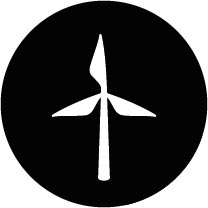THE PLACE AND PURPOSE
THE PLACE AND PURPOSE
The main reason for creating 1101* is, quite simply, that the world is changing. We humans need more energy but our existing energy supply is already placing an unsustainable burden on the planet’s ecocycle. Here we explain more about how 1101* contributes to the necessary transition.
The main reason for creating 1101* is, quite simply, that the world is changing. We humans need more energy but our existing energy supply is already placing an unsustainable burden on the planet’s ecocycle. Here we explain more about how 1101* contributes to the necessary transition.
TEXT & PHOTO: ANDERS WESTERGREN
THE AREA CALLED MARKBYGDEN in the Municipality of Piteå is, essentially, a large plateau, a ridge in the landscape around 20-50 km from the Bottenviken coast. Markbygden was “discovered” as a wind resource with the aid of a software simulation developed by Professor Hans Bergström, a meteorologist at Uppsala University.
The location of the Markbygden plateau between two river valleys creates an acceleration effect in the layer of air at ground-level. In meteorology terms, this is known as the “flow over hill effect”. In practical terms, this produces a high annual average wind speed in Markbygden that, contrary to many expectations, is strongest in the winter. This also means that energy generation is highest in the winter, when the demand for energy is at its greatest.
Another important advantage of Markbygden from a wind power perspective is that two of the national grid’s 400 kV cables (the largest of the Swedish network’s cables) pass through the area, which naturally makes distribution easier.
TEXT & PHOTO: ANDERS WESTERGREN
THE AREA CALLED MARKBYGDEN in the Municipality of Piteå is, essentially, a large plateau, a ridge in the landscape around 20-50 km from the Bottenviken coast. Markbygden was “discovered” as a wind resource with the aid of a software simulation developed by Professor Hans Bergström, a meteorologist at Uppsala University.
The location of the Markbygden plateau between two river valleys creates an acceleration effect in the layer of air at ground-level. In meteorology terms, this is known as the “flow over hill effect”. In practical terms, this produces a high annual average wind speed in Markbygden that, contrary to many expectations, is strongest in the winter. This also means that energy generation is highest in the winter, when the demand for energy is at its greatest.
Another important advantage of Markbygden from a wind power perspective is that two of the national grid’s 400 kV cables (the largest of the Swedish network’s cables) pass through the area, which naturally makes distribution easier.
KILOWATT MEGAWATT TERAWATT?
KILOWATT MEGAWATT TERAWATT?
KILOWATT MEGAWATT TERAWATT?
THE PERMIT FOR AND SIZE OF the 1101* wind farm are primarily about how much power we are permitted to install in the area, rather than the specific number of wind turbines. When the project first started in 201?, we based our plans on the technology available at the time, which would require around 1100 turbines to achieve the highest permitted power output.
With wind power becoming a priority concern in many quarters, considerable advances have been made in recent years. When construction of 1101* began, the preference was to install wind turbines with a capacity of around 2.3 MW. In other parts of Phase 1, completed in 2020, the turbines have a capacity of 3.6 MW. The models installed later, in Phase 2, are 5.3 MW turbines, and so it continues. In these few years alone, there has thus been a 130% increase in the capacity of the turbines.
Before the full completion of 1101*, it is therefore likely that we will see larger and more efficient turbines, which will ultimately mean that the total number of turbines will be smaller than initially planned (with the same or even higher energy production). Whatever happens, Markbygden 1101* will be one of the world’s largest land-based wind farms in terms of size, capacity and energy production.
THE PERMIT FOR AND SIZE OFthe 1101* wind farm are primarily about how much power we are permitted to install in the area, rather than the specific number of wind turbines. When the project first started in 201?, we based our plans on the technology available at the time, which would require around 1100 turbines to achieve the highest permitted power output.
With wind power becoming a priority concern in many quarters, considerable advances have been made in recent years. When construction of 1101* began, the preference was to install wind turbines with a capacity of around 2.3 MW. In other parts of Phase 1, completed in 2020, the turbines have a capacity of 3.6 MW. The models installed later, in Phase 2, are 5.3 MW turbines, and so it continues. In these few years alone, there has thus been a 130% increase in the capacity of the turbines.
Before the full completion of 1101*, it is therefore likely that we will see larger and more efficient turbines, which will ultimately mean that the total number of turbines will be smaller than initially planned (with the same or even higher energy production). Whatever happens, Markbygden 1101* will be one of the world’s largest land-based wind farms in terms of size, capacity and energy production.
POWER & PRODUCTION
POWER & PRODUCTION
Installed capacity is one thing. But what about the scale of the actual energy production? How much energy can we extract and what is that comparable to in a consumer context? When talking about output and energy production, we use the term “capacity factor”, which is given as a percentage. The capacity factor compares actual production with what would have been generated if the turbines ran at max capacity 24/7, all year round.
Installed capacity is one thing. But what about the scale of the actual energy production? How much energy can we extract and what is that comparable to in a consumer context? When talking about output and energy production, we use the term “capacity factor”, which is given as a percentage. The capacity factor compares actual production with what would have been generated if the turbines ran at max capacity 24/7, all year round.

THIS MEANS THAT; if a turbine produces the maximum amount possible, around the clock and all year, the capacity factor is 100%. A turbine within 1101* currently has a capacity factor of around 30-40%. As an example, this generates:
5.3 MW (turbine capacity) x 24 hours x 365 days x 0.35 (average capacity factor) = 16,249 MWh
16,249 MWh = 16,249,000 KWh

One year’s worth of energy for around 6800 electric cars driving 12,000 km per year.

Annual electricity consumption of 800 houses with electrical heating.

THIS MEANS THAT; if a turbine produces the maximum amount possible, around the clock and all year, the capacity factor is 100%. A turbine within 1101* currently has a capacity factor of around 30-40%. As an example, this generates:
5.3 MW (turbine capacity) x 24 hours x 365 days x 0.35 (average capacity factor) = 16,249 MWh
16,249 MWh = 16,249,000 KWh

Energi under ett år till cirka 6800 elbilar med en körsträcka på 1200 mil per år.

Årlig elförbrukning i cirka 800 villor med direktverkande el.
THE EXAMPLE ABOVE is for a single 5.3 MW turbine. If we expand our view, total production on the 1101* site is forecast to be around 12 TWh. And that figure could be higher, depending on technical advances and uprated permits.
So what does 12 TWh equate to?
- Around 7% of Sweden’s total energy production, and 9% of Sweden’s energy use.
- Around the amount of energy required to replace all of Sweden’s 5 million cars with electric cars charged to cover an average of around 12,000 km per year.
- Electricity for around 26% of all Sweden’s permanent residences and holiday homes.
In addition to adding capacity to Sweden’s overall energy supply, we are seeing a growing trend for new commercial developments right next to green energy sources. In 1101*’s case, this could mean everything from energy storage to entirely unrelated businesses with major energy needs that choose Piteå and Norrbotten for their future expansion and projects.
We will see what tomorrow brings. But whatever it is, 1101* will play a key role.
THE EXAMPLE ABOVE is for a single 5.3 MW turbine. If we expand our view, total production on the 1101* site is forecast to be around 12 TWh. And that figure could be higher, depending on technical advances and uprated permits.
So what does 12 TWh equate to?
- Around 7% of Sweden’s total energy production, and 9% of Sweden’s energy use.
- Around the amount of energy required to replace all of Sweden’s 5 million cars with electric cars charged to cover an average of around 12,000 km per year.
- Electricity for around 26% of all Sweden’s permanent residences and holiday homes.
In addition to adding capacity to Sweden’s overall energy supply, we are seeing a growing trend for new commercial developments right next to green energy sources. In 1101*’s case, this could mean everything from energy storage to entirely unrelated businesses with major energy needs that choose Piteå and Norrbotten for their future expansion and projects.
We will see what tomorrow brings. But whatever it is, 1101* will play a key role.